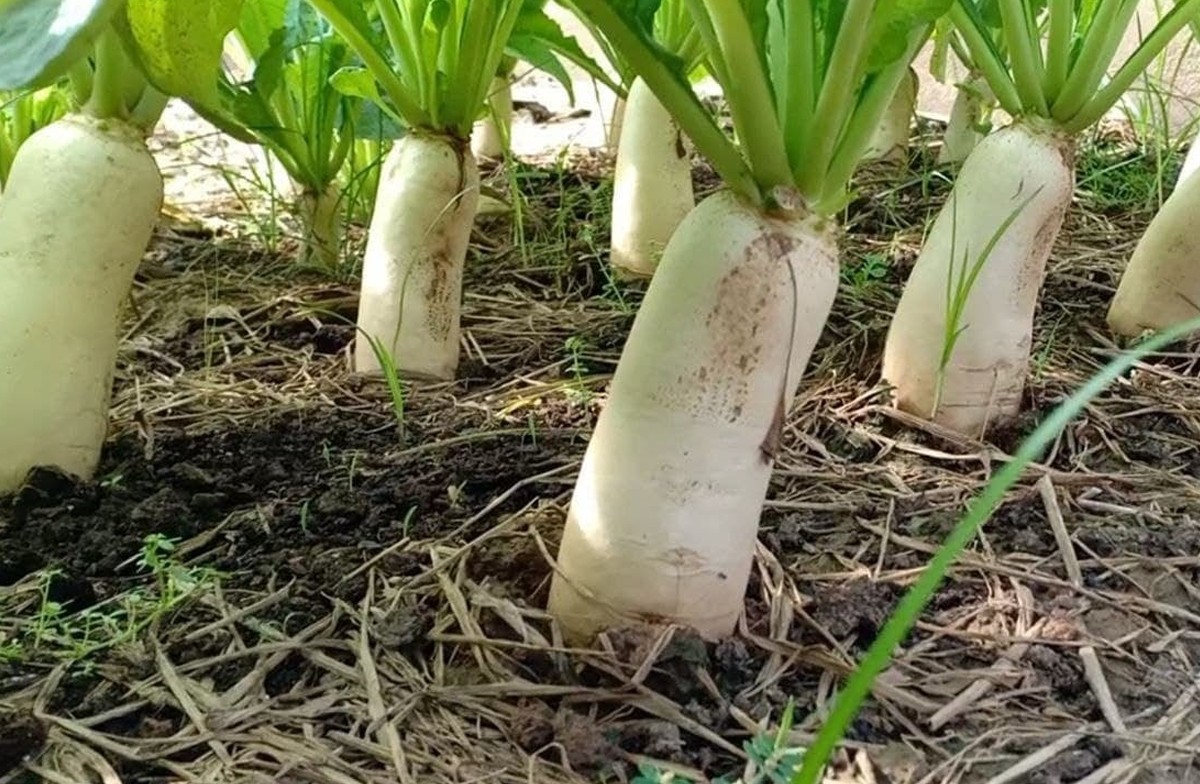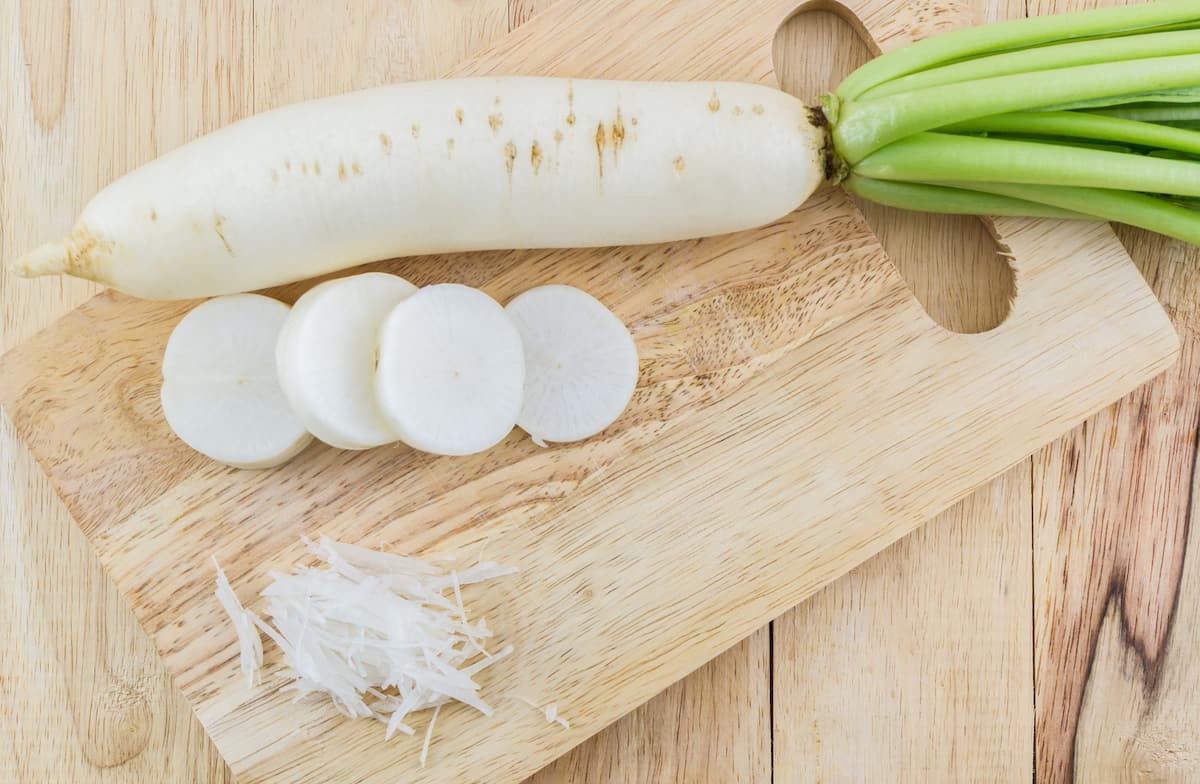Radish
The radish plant, scientifically known as Raphanus sativus, is a root vegetable belonging to the Brassicaceae family. It is grown for its edible root, which comes in various shapes, sizes, and colors, depending on the variety. Here are some key characteristics and information about the radish plant:
- Growth Habit: Radish plants are annuals, meaning they complete their life cycle within a single year. They are fast-growing plants that reach maturity relatively quickly, typically within 20 to 60 days, depending on the variety.
- Root Shape and Color: Radish roots come in a range of shapes, including round, oval, cylindrical, or elongated. The size of the roots can vary from small to medium or even large, depending on the variety. Radishes can be found in different colors, such as red, pink, white, purple, or even black.
- Foliage: The radish plant has a rosette of leaves that grow directly from the root. The leaves are typically green and pinnately divided, with lobes or leaflets arranged along a central stem. The foliage of radish plants is also edible and can be consumed in salads or cooked dishes.
- Cultivation: Radishes are cool-season crops and prefer mild temperatures for optimal growth. They can be grown in both spring and fall, depending on the climate. Radish plants prefer well-drained soil that is rich in organic matter. They require regular watering to ensure consistent moisture in the soil.
- Culinary Uses: Radishes are primarily grown for their roots, which are consumed raw or cooked in various culinary preparations. They add a crunchy texture and a mildly spicy or peppery flavor to salads, sandwiches, stir-fries, and other dishes. The leaves of radish plants are also edible and can be used as a leafy green vegetable in salads or cooked like other leafy greens.
- Nutritional Value: Radishes are low in calories and rich in vitamins and minerals. They are a good source of vitamin C, potassium, folate, and fiber. Radishes also contain antioxidants, such as anthocyanins and isothiocyanates, which contribute to their potential health benefits.
Radishes are versatile and easy to grow, making them a popular choice for home gardeners. They are often used as a companion plant in vegetable gardens to help deter pests and improve soil health. With their relatively short growing season, radishes are a great option for gardeners looking for a quick and rewarding harvest.
In natural health, radish (Raphanus sativus) has been used for centuries for its medicinal properties. Here are some ways radish is used in natural health:
- Energy and Temperature: Radish is considered energetically cooling in natural health. It is believed to clear heat and toxins from the body, making it beneficial for conditions associated with excess heat, such as sore throat, fever, and skin rashes. Radish is also believed to have a downward energy that helps clear stagnation in the digestive system.
- Digestive Health: Radish is commonly used to support digestive health in natural health. It is believed to stimulate the digestive system, improve appetite, and aid in the digestion of fatty and greasy foods. Radish is also thought to promote bowel movements and relieve constipation.
- Respiratory Health: Radish is used in natural health to address respiratory issues. It is believed to help dissolve phlegm and relieve congestion, making it useful for conditions like coughs, bronchitis, and sinus congestion.
- Detoxification: Radish is considered to have detoxifying properties in natural health. It is believed to support the liver's detoxification functions and help eliminate toxins from the body.
- Diuretic Effect: Radish is used as a diuretic in natural health, meaning it helps promote urine production and can be beneficial for conditions related to water retention or edema.
- Nutritional Benefits: In natural health, radish is valued for its nutritional content. It is considered to be rich in vitamins (especially vitamin C), minerals, and dietary fiber, which can support overall health and vitality.
It's important to note that the use of radish in natural health is often as part of a larger treatment plan that takes into consideration an individual's unique constitution, symptoms, and overall health. Radish is typically consumed as a food or included in herbal formulations in natural health.
Radish nutritional benefits
Radishes are low-calorie root vegetables that offer a range of nutritional benefits. Here are some key nutritional benefits of radishes:
- Vitamins and Minerals: Radishes are a good source of various vitamins and minerals. They are particularly rich in vitamin C, which supports immune function, collagen production, and acts as an antioxidant in the body. Radishes also contain small amounts of vitamins such as vitamin K, vitamin B6, folate, and minerals like potassium and manganese.
- Dietary Fiber: Radishes are a good source of dietary fiber, which is important for digestive health. Fiber adds bulk to the diet, promotes regular bowel movements, and can help prevent constipation.
- Hydration: Radishes have a high water content, which can contribute to hydration and overall fluid balance in the body. Staying adequately hydrated is essential for various bodily functions, including temperature regulation and nutrient transportation.
- Antioxidant Compounds: Radishes contain antioxidant compounds such as anthocyanins, flavonoids, and isothiocyanates. These compounds help protect cells from oxidative stress and damage caused by harmful free radicals, which may contribute to chronic diseases and aging.
- Potential Anti-Inflammatory Effects: Some research suggests that radishes may have anti-inflammatory properties. Certain compounds found in radishes, such as isothiocyanates and anthocyanins, have been studied for their potential anti-inflammatory effects, which may help reduce inflammation in the body.
- Low-Calorie and Weight Management: Radishes are low in calories and high in fiber, making them a satisfying addition to a balanced diet. Including radishes in meals can help promote feelings of fullness while keeping calorie intake in check, which may be beneficial for weight management.
- Digestive Health: The fiber content in radishes supports digestive health by promoting regular bowel movements and preventing constipation. Additionally, radishes contain compounds that can help stimulate bile production, aiding in digestion and supporting liver health.
Redish pharmacological action
Radishes (Raphanus sativus) possess various pharmacological actions that contribute to their potential health benefits. Here are some pharmacological actions associated with radishes:
- Antioxidant Activity: Radishes contain antioxidant compounds such as anthocyanins, flavonoids, and isothiocyanates. These compounds have been shown to exhibit antioxidant activity, which helps protect cells from oxidative stress and scavenges free radicals in the body.
- Anti-Inflammatory Effects: Some studies have suggested that radishes may have anti-inflammatory properties. Compounds found in radishes, such as isothiocyanates, have demonstrated potential anti-inflammatory effects by inhibiting pro-inflammatory enzymes and cytokines.
- Antimicrobial Activity: Radishes have been found to possess antimicrobial properties against certain bacteria and fungi. The antimicrobial activity of radishes is attributed to compounds like glucosinolates and isothiocyanates, which have shown inhibitory effects against various pathogenic microorganisms.
- Diuretic Effect: Radishes have diuretic properties, meaning they promote urine production and increase the excretion of fluids from the body. This diuretic effect may help in reducing water retention and promoting kidney function.
- Hepatoprotective Effects: Some studies have indicated that radishes exhibit hepatoprotective properties, which means they help protect the liver from damage. Radishes have been shown to enhance antioxidant defense systems and reduce oxidative stress in the liver.
- Hypoglycemic Activity: Radishes have been investigated for their potential hypoglycemic activity, meaning they may help lower blood sugar levels. Certain compounds found in radishes, such as fiber and sulfur-containing compounds, have shown promising effects in animal studies by improving glucose metabolism and insulin sensitivity.
How to plant radish
Planting radishes is relatively simple and can be done in a few easy steps. Here's a guide on how to plant radishes:
- Choose the Right Time: Radishes are cool-season crops and prefer moderate temperatures for optimal growth. They can be planted in early spring or late summer/early fall, depending on your climate. Avoid planting radishes during the hottest months of summer.
- Select a Suitable Location: Radishes prefer a location that receives full sun or partial shade. Ensure that the soil is well-drained and loose, as compacted soil can hinder root development.
- Prepare the Soil: Before planting, prepare the soil by removing any weeds, rocks, or debris. Loosen the soil to a depth of about 6 to 8 inches (15 to 20 cm) using a garden fork or tiller. Incorporate organic matter, such as compost or well-rotted manure, to improve soil fertility and drainage.
- Sow the Seeds: Radish seeds are small and can be sown directly into the garden bed. Make shallow furrows in the soil about half an inch (1.25 cm) deep, spaced around 2 to 4 inches (5 to 10 cm) apart. Drop the radish seeds into the furrows, spacing them about 1 inch (2.5 cm) apart. Cover the seeds with soil and gently firm it down.
- Watering: After sowing the seeds, water the soil thoroughly but gently to ensure even moisture. Keep the soil consistently moist but not waterlogged throughout the germination and growing period. Avoid overwatering, as it can lead to rotting or splitting of the radish roots.
- Thin the Seedlings: Once the radish seedlings emerge and have a few leaves, thin them to allow proper spacing for growth. Radishes need sufficient space to develop their roots. Thin the seedlings to about 2 to 3 inches (5 to 7.5 cm) apart. The thinned seedlings can be consumed as microgreens or used in salads.
- Maintenance: Keep the area around the radish plants free from weeds, as they can compete for nutrients and water. Mulching can help suppress weeds and maintain soil moisture. Regularly monitor the soil moisture and water as needed to prevent drying out.
- Harvesting: Radishes mature relatively quickly, usually within 20 to 60 days depending on the variety. They are typically harvested when the roots are of the desired size and firmness. For most varieties, this is when the radish roots are about 1 to 2 inches (2.5 to 5 cm) in diameter. Gently pull the radishes from the soil, and trim the tops if desired.
By following these steps, you can successfully plant and grow your own radishes, enjoying their fresh and crunchy roots in a relatively short period of time.
Redish leaves benefits
In natural health, radish leaves are sometimes used for their medicinal properties. While the primary focus in natural health is often on the radish root, the leaves can also be utilized. Here are a few ways radish leaves are used in natural health:
- Clearing Heat: Radish leaves are believed to have cooling properties that can help clear heat from the body. Heat conditions may manifest as symptoms like fever, sore throat, or skin irritations. Consuming radish leaves is thought to help cool the body and alleviate these symptoms.
- Detoxification: In natural health, radish leaves are believed to support the body's detoxification processes. They are thought to have a cleansing effect on the liver and promote the elimination of toxins from the body.
- Digestive Support: Radish leaves are considered beneficial for digestion. They are believed to stimulate appetite, aid in digestion, and promote the flow of Qi (energy) in the digestive system. Radish leaves may be used to alleviate symptoms such as indigestion, bloating, or abdominal discomfort.
- Nutritional Benefits: Radish leaves are rich in nutrients, including vitamins (such as vitamin C and vitamin K), minerals, and dietary fiber. In natural health, the nutritional content of radish leaves is considered supportive of overall health and vitality.
In Person With Heshoutang Natural Health Members
With Heshoutang Natural Health Online Members
Fill Out the Questionnaire by yourself
Radish seed benefits
In natural health, radish seeds are known as "Lai Fu Zi Zi" and are used for their medicinal properties. Here are some ways radish seeds are used in natural health:
- Digestive Health: Radish seeds are believed to have a warming effect and are often used in natural health to support digestive health. They are believed to help promote the flow of Qi (energy) in the digestive system, alleviate abdominal bloating and discomfort, and aid in digestion.
- Phlegm and Cough: Radish seeds are commonly used in natural health to address conditions characterized by excess phlegm and coughing. They are believed to have expectorant properties, helping to dissolve and eliminate phlegm from the respiratory system, making them beneficial for coughs, bronchitis, and other respiratory issues.
- Diuretic Effect: Radish seeds are used as a diuretic in natural health. They are believed to promote urine production and help eliminate excess fluids from the body, making them potentially useful for conditions related to water retention or edema.
- Nutritional Benefits: Radish seeds are considered to be nutritious in natural health. They are a source of vitamins, minerals, and dietary fiber, which can contribute to overall health and vitality.
When you subscribe to the blog, we will send you an e-mail when there are new updates on the site so you wouldn't miss them.


















Comments